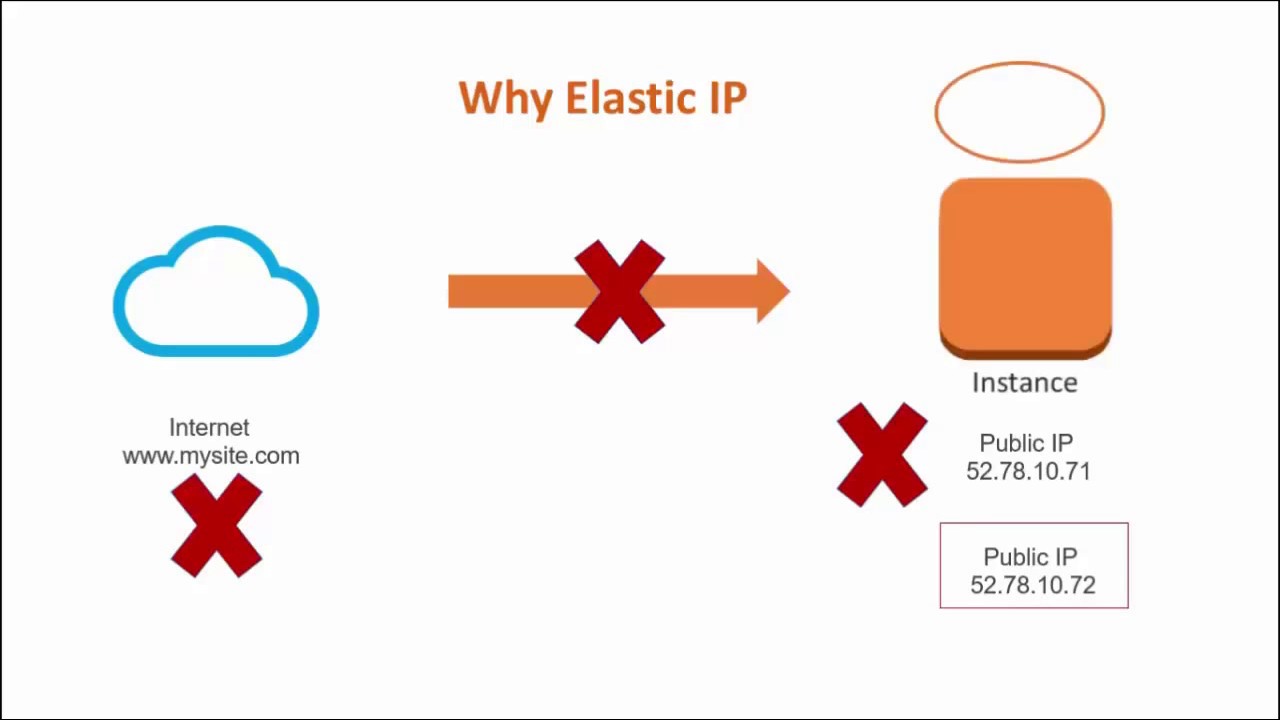Introduction
In today’s interconnected digital landscape, having a reliable and flexible infrastructure is crucial for businesses to thrive online. One aspect of this infrastructure is the allocation and management of IP addresses, which are unique identifiers used to locate and communicate with devices on a network. In the world of cloud computing, a powerful service called Elastic IP offers a solution to the challenge of maintaining a stable and flexible IP address for your cloud-based resources.
Elastic IP, also known as Elastic IP address, is a feature provided by various cloud service providers that allows you to assign a static and persistent IP address to your cloud resources. Unlike traditional IP addresses that are tied to specific hardware, Elastic IP addresses can be easily reassigned to different instances or services within your cloud environment. This flexibility makes it a valuable tool for businesses that require stable and predictable IP addresses for their online applications, without the limitations of being tied to a specific piece of hardware.
The concept behind Elastic IP is simple yet powerful. Instead of relying on the dynamic allocation of IP addresses, where IP addresses change each time an instance is started or stopped, Elastic IP provides a fixed address that you can associate with your cloud resources. This allows you to maintain a consistent and easily recognizable IP address for your services, even if the underlying infrastructure changes.
By utilizing Elastic IP, businesses can enjoy several benefits. Firstly, it provides a reliable and predictable address for your cloud resources, making it easier for clients and other services to connect with your applications. Additionally, Elastic IP addresses can be easily remapped to different instances or services, providing seamless failover capabilities in case of hardware or software issues. This flexibility also enables efficient resource management, as you can easily reassign or release IP addresses as needed, without needing to update DNS records or reconfigure your applications.
When it comes to deciding whether to use Elastic IP, there are certain scenarios where it is particularly beneficial. If you are running a web application that requires a consistent IP address for SSL/TLS certificate installation or direct client access, Elastic IP can provide the stability you need. Similarly, if you are hosting services that need to be whitelisted by third-party providers, having a static IP address can simplify the process. Additionally, if you are planning to architect highly available systems or disaster recovery solutions, Elastic IP can play a crucial role in maintaining service continuity during failover events.
Next, we will explore how to assign an Elastic IP to your EC2 instance and discuss various management and configuration options for Elastic IP addresses.
Definition of Elastic IP
In the world of cloud computing, an Elastic IP (EIP) is a unique public IP address that is associated with your cloud resources, such as instances or load balancers. Unlike traditional IP addresses that are dynamically allocated to instances each time they are started or stopped, an Elastic IP is static and persists even if you terminate the instance it is associated with.
An Elastic IP essentially acts as a virtual address that you can attach to your cloud resources, providing consistent and reliable access to those resources. It allows you to maintain a fixed reference point for your applications, making it easier for clients, third-party services, and users to connect reliably to your instances or services, even if there are changes in the underlying infrastructure.
One of the key advantages of Elastic IP is its flexibility of association. You can easily associate an Elastic IP with different instances or services within your cloud environment. This means that if you need to replace an instance due to hardware failure or scaling requirements, you can simply detach the Elastic IP from the old instance and associate it with the new one, avoiding the need to update DNS records or notify clients of a change in IP address.
It’s important to note that Elastic IP addresses are limited per AWS region or cloud provider. The exact limit depends on the cloud provider’s policies. In addition, there might be charges associated with using Elastic IP, especially if the IP address is not associated with a running instance or if there are frequent changes in association. Therefore, it’s essential to carefully manage and optimize the usage of Elastic IP addresses to avoid unnecessary costs.
To summarize, an Elastic IP is a static and persistent public IP address that can be associated with cloud resources like instances or load balancers. It provides a reliable and fixed reference point for your applications and allows for seamless association with different instances or services. By using Elastic IP, you can maintain consistent connectivity and enhance the overall stability and manageability of your cloud environment.
How Does an Elastic IP Work?
To understand how an Elastic IP (EIP) works, it’s important to have a basic understanding of how IP addresses function in the context of cloud computing. In most cloud environments, instances are assigned dynamic IP addresses that can change each time the instance is started or stopped. While this dynamic allocation is convenient in many cases, it can cause challenges when you require a persistent and stable IP address for your applications or services.
An Elastic IP solves this problem by providing a static and persistent IP address that you can associate with your cloud resources. When you allocate an Elastic IP, it is reserved for your account and can be associated with any running instance within the same region. This address remains unchanged even if you stop or terminate the instance it was originally associated with, allowing you to maintain a fixed reference point for your applications.
The process of assigning an Elastic IP involves three main steps. First, you need to allocate an Elastic IP address from the pool of available addresses in your cloud provider’s network. Once allocated, the Elastic IP is associated with your account and is ready for use. However, it’s important to note that the assigned Elastic IP is not yet associated with any specific instance or service.
The next step is to associate the Elastic IP with a running instance or service within your cloud environment. This can be done through the cloud provider’s management console, command-line interface, or API. Once the association is made, the Elastic IP becomes the public address by which the instance or service can be accessed.
It’s worth mentioning that you can associate the same Elastic IP with multiple instances or services. This can be useful in scenarios where you have instances in different availability zones or need to distribute traffic across multiple instances. However, it’s important to consider the limitations and implications of this configuration, such as network bandwidth and security considerations.
In addition to assigning and associating Elastic IP addresses, you also have the ability to manage and modify their configuration. For example, you can release an Elastic IP address if you no longer need it, freeing it up for other use within your account. You can also disassociate an Elastic IP from an instance without releasing it, allowing you to associate it with a different instance within the same region.
To summarize, an Elastic IP address is a static and persistent IP address that can be associated with running instances or services within your cloud environment. By allocating and assigning an Elastic IP, you can maintain consistent connectivity and provide a reliable reference point for your applications. This flexibility allows for seamless association and management of IP addresses, enhancing the stability and accessibility of your cloud resources.
Benefits of Using Elastic IP
The use of Elastic IP (EIP) addresses provides several benefits for businesses and organizations operating in the cloud environment. Let’s explore some of the key advantages of utilizing Elastic IP in your infrastructure.
1. Stability and Consistency: Elastic IP allows you to maintain a static and persistent IP address for your cloud resources. This stability ensures that your applications and services can be reliably accessed by clients, users, and third-party services without the need for frequent IP address changes.
2. Seamless Failover: In cases where an instance or service fails or needs to be replaced, you can easily detach the Elastic IP from the failed instance and associate it with a new one. This enables seamless failover and ensures continuity of your services without requiring updates to DNS records or notifying clients about IP address changes.
3. SSL/TLS Certificates: If you require SSL/TLS certificates for secure communication, having a static IP address provided by Elastic IP simplifies the certificate installation process. With a consistent IP address, you can easily manage and update your certificates without concerns about IP address changes affecting your certificate validity.
4. Whitelisting: Many third-party services, APIs, and security measures require whitelisting of IP addresses for access. By using an Elastic IP, you can easily provide a static IP address for whitelisting purposes, ensuring uninterrupted access to those services and avoiding the need for frequent updates as IP addresses change.
5. Efficient Resource Management: Elastic IP provides flexibility in managing your cloud resources. You can easily reassign or release IP addresses as required, minimizing IP address wastage and optimizing resource allocation. This can be particularly beneficial in scenarios where you have scalability needs or frequently spin up and shut down instances.
6. Network Traffic Control: With Elastic IP, you have more control over network traffic. You can distribute incoming traffic across multiple instances by associating the same Elastic IP with different instances in different availability zones. This allows for load balancing and fault tolerance, ensuring high availability and performance.
7. Cost Optimization: While there may be costs associated with using Elastic IP, such as idle IP address charges, by carefully managing and optimizing your IP address usage, you can avoid unnecessary expenses. Only allocate and retain the Elastic IP addresses you truly need, and release any that are no longer in use, allowing them to be utilized by other resources within your account.
In summary, utilizing Elastic IP addresses offers stability, flexibility, and control over your cloud resources. By providing a static and persistent IP address, Elastic IP simplifies the management of your applications, enhances failover capabilities, and streamlines processes such as SSL/TLS certificate installation and IP whitelisting. Additionally, through efficient resource management and network traffic control, you can optimize costs and ensure high availability and performance for your cloud-based services.
When Should You Use Elastic IP?
Elastic IP (EIP) addresses are a valuable tool in certain scenarios where a stable and persistent IP address is crucial for your cloud-based applications or services. Let’s explore some situations where using an Elastic IP would be beneficial.
1. Persistent IP Address: If your application or service requires a consistent IP address that does not change, an Elastic IP is an ideal choice. This is particularly important for applications that rely on direct client access or if you need to update DNS records or firewall rules with a static IP.
2. SSL/TLS Certificates: If you are using SSL/TLS certificates to secure your applications or websites, having a static IP provided by an Elastic IP makes certificate management easier. You can associate the Elastic IP with the instance hosting your application, simplifying the certificate installation process and avoiding any disruption due to IP address changes.
3. Third-Party Connections: Many third-party services, APIs, or partners may require whitelisting of IP addresses for access. By using an Elastic IP, you can provide a static IP address for such purposes. This ensures uninterrupted access to those services without the need for frequent updates as IP addresses change in your cloud infrastructure.
4. Failover and High Availability: If you are designing a highly available system or implementing disaster recovery solutions, Elastic IP addresses play a crucial role. By associating the Elastic IP with a secondary instance in a different availability zone, you can easily switch traffic to the secondary instance if the primary instance fails, ensuring minimal downtime and seamless failover.
5. Restrictive Access Controls: In some cases, your application or services may need to be accessed only from specific IP addresses or IP ranges. Using an Elastic IP allows you to define and manage access control lists or firewall rules, ensuring that only authorized IP addresses are allowed to connect to your resources.
6. Static Network Address Translation (SNAT): Elastic IP addresses can be useful in scenarios where you need to configure outbound traffic from your instances with a static source IP address. This can be important for certain applications or services that rely on outbound connections and require consistent IP addresses for security or connectivity purposes.
These are just a few examples of when utilizing an Elastic IP would be advantageous. It’s important to carefully assess your specific requirements and consider factors such as scalability, security, and stability when determining whether to use an Elastic IP for your cloud resources.
How to Assign an Elastic IP to Your EC2 Instance
Assigning an Elastic IP (EIP) to your EC2 instance is a straightforward process that can be accomplished using the AWS Management Console, AWS CLI (Command Line Interface), or SDKs (Software Development Kits). Here’s a step-by-step guide on how to assign an Elastic IP to your EC2 instance through the AWS Management Console:
- Open the AWS Management Console, navigate to the EC2 dashboard, and select “Elastic IPs” from the left-hand menu.
- Click on the “Allocate new address” button to generate a new Elastic IP address. You can also choose to allocate from your available address pool if you have already allocated Elastic IPs.
- Once the Elastic IP address is allocated, select the address from the list, and click on the “Actions” button.
- In the dropdown menu, select “Associate IP address” to assign the Elastic IP to an EC2 instance.
- In the “Associate Elastic IP address” dialog box, select the EC2 instance you want to associate with the Elastic IP from the dropdown menu.
- Optionally, you can choose to enable the “Reassociation” checkbox if you want the Elastic IP to be automatically reassigned to the instance if it’s stopped and started again.
- Click on the “Associate” button to complete the process. The Elastic IP will be associated with the selected EC2 instance.
Once the Elastic IP is successfully associated with the EC2 instance, the instance will have a public IP address assigned to it, allowing for direct access from the internet or other authorized networks.
It’s important to note that when an Elastic IP is associated with an EC2 instance, the instance will lose its previously assigned public IP address. The Elastic IP effectively replaces the public IP address, providing a static and persistent IP that remains unchanged even if the instance is stopped and restarted.
To disassociate an Elastic IP from an EC2 instance, you can follow a similar process in the AWS Management Console. Simply navigate to the Elastic IPs section, select the Elastic IP you want to disassociate, click on the “Actions” button, and choose “Disassociate IP address”. This will detach the Elastic IP from the EC2 instance, allowing you to associate it with another instance or release it back to the pool of available IP addresses.
Remember, you can also perform these operations programmatically using the AWS CLI or SDKs, allowing for automation and integration into your existing infrastructure management workflows.
Managing Elastic IP Addresses
Managing Elastic IP (EIP) addresses involves various tasks such as allocation, association, disassociation, and release. Here are some key aspects to consider when managing your Elastic IP addresses:
1. Allocation: When you allocate an Elastic IP address, it is reserved for your account and remains associated until you explicitly release it. You can allocate new Elastic IPs from the pool of available addresses in your cloud provider’s network. Keep in mind that there might be limits on the number of Elastic IPs you can allocate per region, based on your cloud provider’s policies.
2. Association: Associating an Elastic IP address with an instance allows you to establish a fixed public IP address for that instance. You can associate an Elastic IP either during the instance launch or after the instance is running. This association is done on a one-to-one basis, meaning each Elastic IP can only be associated with one instance at a time. However, you can associate the same Elastic IP with different instances if needed.
3. Disassociation: Disassociating an Elastic IP from an instance detaches it from the instance, allowing you to associate it with another instance or service within the same region. This can be done through the cloud provider’s management console, CLI, or API. It’s worth noting that disassociating an Elastic IP does not release it, meaning it remains allocated to your account and can be reused.
4. Reassociation: Some cloud providers offer the option to enable automatic reassociation when an instance associated with an Elastic IP is stopped and started again. This ensures that the Elastic IP remains attached to the instance even after a reboot or a stop-start cycle, providing a consistent IP address over the instance’s lifecycle.
5. Release: Releasing an Elastic IP removes it from your account and returns it to the pool of available addresses. It’s important to release any Elastic IP addresses that are no longer in use to avoid unnecessary charges and optimize resources. Release can be performed through the management console, CLI, or API.
6. Tagging: Tagging your Elastic IP addresses with meaningful labels allows for better organization and management of your resources. Tags can help you categorize and group Elastic IPs based on projects, environments, departments, or any other relevant criteria, making it easier to identify and manage them.
7. Monitoring and Reporting: Monitoring the usage and activity of your Elastic IP addresses can provide valuable insights into the performance and behavior of your applications. Monitoring tools provided by your cloud provider or third-party monitoring solutions can help you track metrics, such as data transfer, bandwidth usage, and availability of your Elastic IP addresses.
By effectively managing your Elastic IP addresses, you can ensure optimal utilization of your resources, maintain stable connectivity for your applications, and streamline your network infrastructure management procedures.
Configuration Options for Elastic IP
Elastic IP (EIP) addresses come with various configuration options that allow you to customize their behavior and optimize their usage within your cloud environment. Let’s explore some of the key configuration options available for Elastic IP addresses:
1. Provisioning Type: Some cloud providers offer different types of Elastic IP provisioning, such as basic and standard. The basic type is usually free and is designed for standard usage, while the standard type may offer additional features and functionalities at a cost. It’s advisable to review your cloud provider’s documentation to understand the provisioning types and any associated charges.
2. Reassociation: When an instance associated with an Elastic IP is stopped and started again, you can choose whether to automatically reassociate the Elastic IP with the instance. Enabling this option ensures that the instance retains the same IP address when it is rebooted or undergoes a stop-start cycle. This can be useful to maintain consistent connectivity and configuration for your applications.
3. Reverse DNS (rDNS) Configuration: Reverse DNS allows you to configure a domain name to resolve to the IP address associated with your Elastic IP. This can be beneficial for applications that rely on reverse IP lookups for security measures, email delivery, or other purposes. Some cloud providers allow you to configure the reverse DNS record for your Elastic IP address either through the management console or via API.
4. Network ACLs and Security Groups: Elastic IP addresses are subject to the network access control lists (ACLs) and security group rules that you have configured for your instances. Ensure that you have the appropriate rules defined to allow inbound and outbound traffic to and from the Elastic IP address, as per your application and security requirements.
5. Elastic IP Pools: In some cases, cloud providers offer the capability to create and manage pools of Elastic IP addresses. This allows you to group and allocate your Elastic IPs based on specific purposes or criteria, such as different projects, departments, or environments. Using IP pools can provide better organization and management of your Elastic IP resources.
6. Elastic IP Resolver: Some cloud providers offer a DNS resolver endpoint that allows you to resolve Elastic IP addresses using DNS names. This can be useful when you don’t have access to the management console or need to programmatically resolve the IP address for a specific Elastic IP in your environment.
7. Cross-Region Elastic IP Association: In certain scenarios, you may require an Elastic IP address from one region to be associated with an instance in another region. Some cloud providers support cross-region Elastic IP association, allowing you to associate an Elastic IP from one region with an instance in another region. This can be beneficial for various use cases, such as global load balancing or accessing resources in a different region.
It’s important to review the available configuration options provided by your cloud provider and tailor them to meet your specific requirements. By configuring Elastic IP addresses effectively, you can optimize their use, enhance security, and ensure seamless connectivity for your applications and services within the cloud environment.
Best Practices for Using Elastic IP
To make the most of Elastic IP (EIP) addresses and ensure optimal performance and cost-effectiveness, following best practices is recommended. Here are some key practices to consider when using Elastic IP in your cloud environment:
1. Limit Elastic IP Usage: Allocate and use Elastic IP addresses only when necessary. Keep in mind that there may be limits on the number of Elastic IPs you can allocate per region or account. Avoid allocating more Elastic IPs than you truly need to prevent unnecessary costs and resource usage.
2. Optimize IP Address Utilization: Regularly review and assess the usage of your Elastic IP addresses. Reclaim and release any IP addresses that are no longer in use or have become redundant. This ensures efficient utilization of your available IP addresses and helps avoid IP address depletion.
3. Leverage Elastic IP Tagging: Utilize tags to label and categorize your Elastic IP addresses based on specific criteria such as projects, environments, or departments. This enables better organization, tracking, and management of your IP addresses, making it easier to identify and manage them as your infrastructure scales.
4. Monitor IP Address Activity: Regularly monitor the activity and traffic patterns of your Elastic IP addresses. This can provide insights into the usage and performance of your applications and help identify any potential issues or bottlenecks. Utilize monitoring tools and metrics offered by your cloud provider to gain visibility into IP address traffic and resource utilization.
5. Automate Elastic IP Allocation and Association: Consider using automation tools such as scripts, infrastructure-as-code frameworks, or the AWS CLI to automate the allocation and association of Elastic IPs. This helps streamline the process and ensures consistency and efficiency in managing your IP addresses, especially when dealing with large-scale deployments or frequent changes.
6. Implement Network Access Controls: Establish appropriate network access controls, such as network ACLs and security groups, for your Elastic IP addresses. Ensure that inbound and outbound traffic is properly regulated and only authorized sources are allowed access. This enhances the security and integrity of your applications and minimizes the risk of unauthorized access.
7. Plan for Failover and High Availability: If you are using Elastic IP addresses for highly available systems or disaster recovery configurations, plan and test the failover process. Ensure that you have appropriate mechanisms in place to associate the Elastic IP with standby instances or services during failover events, to minimize downtime and maintain service continuity.
By following these best practices, you can effectively manage and utilize Elastic IP addresses in your cloud environment. This results in optimized resource allocation, improved security, enhanced scalability, and reliable connectivity for your cloud-based applications and services.
Conclusion
Elastic IP (EIP) addresses offer a powerful solution for businesses and organizations that require stable and persistent IP addresses for their cloud resources. By providing a static and flexible IP allocation, Elastic IP addresses ensure consistent connectivity and simplify the management of cloud-based applications and services.
Throughout this article, we’ve explored the definition of Elastic IP, how it works, and the benefits it offers. We’ve discussed the scenarios where Elastic IP is most useful, such as when SSL/TLS certificates need a fixed IP address or when third-party services require whitelisting. We’ve also delved into the steps involved in assigning an Elastic IP to an EC2 instance and managing Elastic IP addresses through allocation, association, disassociation, and release.
Furthermore, we’ve highlighted various configuration options and best practices to optimize the usage of Elastic IP addresses. These include tagging IPs for better organization, monitoring IP address activity, automating allocation and association processes, implementing network access controls, and planning for failover and high availability.
By following these best practices and utilizing the capabilities of Elastic IP, businesses can achieve stability, scalability, and cost efficiency in their cloud infrastructure. Whether it’s maintaining a consistent IP address for SSL/TLS certificates, ensuring reliable connectivity for client access, or enabling seamless failover and high availability, Elastic IP addresses have become an indispensable tool in the cloud computing landscape.
In conclusion, Elastic IP addresses provide the foundation for stable and predictable connectivity in the cloud. Leveraging their flexibility and benefits can enhance the performance, security, and manageability of your cloud-based applications and services, contributing to the overall success of your digital infrastructure.

























